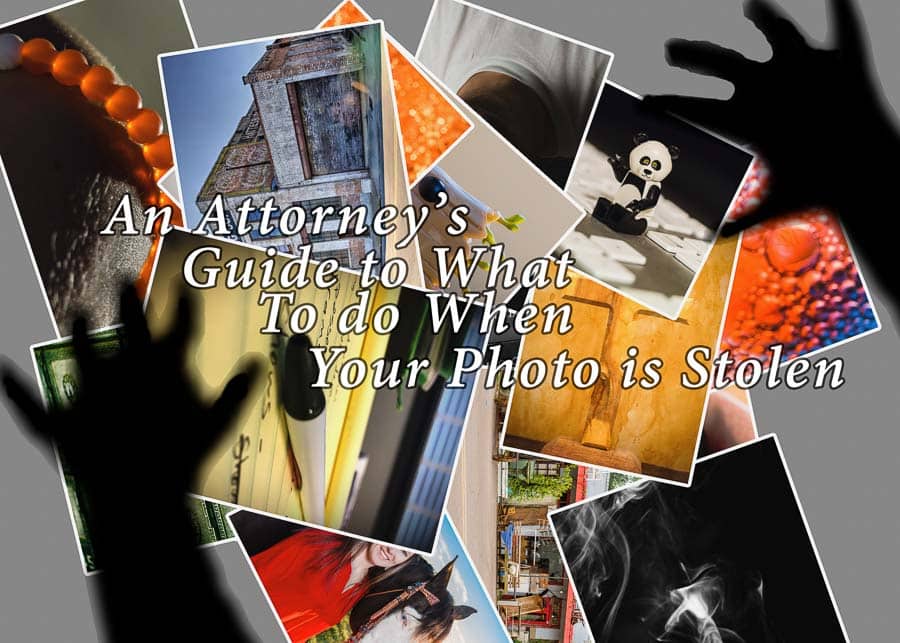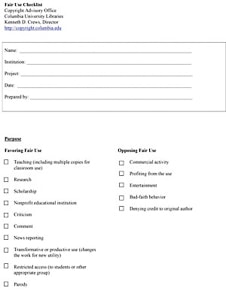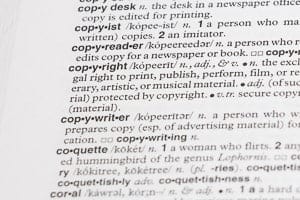
The following is presented for informational purposes only and is not legal advice. Please consult a licensed attorney in your jurisdiction for help with your specific situation.
Now that the disclaimer is out of the way …
Copyright Basics
Legally speaking, photo theft is copyright infringement, so we need to begin by reviewing the basics of copyright.
 What is a copyright?
What is a copyright?
Quite simply, a copyright is a legal right to control the distribution, copying, and alteration of “original works of authorship.” Further, these original works must be “fixed in a tangible medium of expression.”
Under this definition, the fact that two photographs are similar is not enough to be in violation of copyright if it can be proven that the photographers came up with the ideas independent of one another. Similarly, you cannot copyright an idea for a photograph. It must be fixed in a medium (such as film, a hard drive, or a memory card).
Who owns a copyright to a photograph?
Generally, under U.S. copyright law, a photographer owns a copyright to a photograph as soon as the shutter is clicked.
There is, of course, an exception to this rule. If the photograph was produced as a work for hire, the copyright owner is then the person or entity for which the photographer works. The best example of this would be a photographer for a newspaper. The photographer would not own the copyright to any photographs taken in the course of their employment. Rather, the newspaper would own the copyright.
I know the term “work for hire” can be confusing. After all, aren't most photographers hired to perform specific work? Usually, such a photographer would be considered an independent contractor. An independent contractor's photographs are only considered works for hire under very specific circumstances. A discussion of those circumstances is beyond the scope of this article.
What is copyright infringement?
Infringement is a fancy word for someone wrongfully using a work to which another holds the copyright. In this article, the terms infringement, image theft, and photo theft will mean the same thing.
How do you prove you have a copyright?
The best proof of a copyright is to register the photograph with the Copyright Office. One can register a single photograph, a collection of unpublished photographs, or a group of published photographs.
Licensing of Photos
A copyright may be transferred to another person. When this is done, the original copyright “owner” no longer has any right to control the photograph.
It is possible to allow a limited use of a photo by licensing it. Usually, when someone “buys” a photograph from a photographer, they are actually purchasing a license. The photographer retains copyright but grants limited use to the photo. A license usually specifies the limitations on the use of the photo.
Discovering Photo Theft
How does a photographer discover that their work has been stolen? The difficulty in this task is what makes photo theft so easy. Historically, copyright owners either stumble upon the copyright violation or a friend, relative, or admirer of their work discovers the violation and reports it to the copyright owner.
Fortunately, technology has made this task somewhat easier. In recent years, reverse image searching has become available. Users of services such as Tin Eye or Google Images (formerly known as Google reverse image search) can search the Internet to find out where a photo appears. Of course, these services are limited to the sites that they have indexed.
There are similar sites that charge for their services, such as Digimarc, ImageRights, and PicScout. These sites will often not only assist their members in searching for copyright infringements but also assist in enforcing the copyright in exchange for a portion of any monetary recovery. A relatively new service is Pixsy, which is free (as of this time). In exchange for assisting the copyright owner in the enforcement of their copyright, Pixsy receives a portion of any compensation the owner may receive from the photo thief.
Steps to Enforcing Your Copyright
Let's suppose you have found that someone has used one of your photographs without your permission. What now?
In my opinion, you should now consult with a lawyer. I say that not out of some sense of loyalty to the profession, but because copyright law is very technical. Let someone who is already familiar with them deal with the technicalities rather than you try to learn under pressure.

Is there an exception?
The first thing you or an attorney will have to consider is whether there is an exception to your copyright that allows the use of your image. The control that comes with a copyright is not absolute. In fact, the law a copyright owner should allow certain uses of the photo. This is called, unsurprisingly, the doctrine of fair use.
There is no hard and fast rule concerning when a use falls under the fair use doctrine. A court would look at four factors to decide if fair use applied:
- The purpose of the use of the copyrighted material (such as educational, journalistic, or commercial);
- The nature of the copyrighted work;
- How much of the copyrighted work is used in relation to the whole; and
- The effect of the use upon the potential market for, or value of, the copyrighted material.
This determination is not a simple arithmetic comparison; a court can find fair use exists even if only one of those factors is in favor of the use.
Is it worth it?
Sadly, this consideration probably stops more people from enforcing their copyright. Pursuing a copyright infringement case will take dozens, if not hundreds, of hours. This will be expensive. Most people cannot afford to pay legal fees for that much time.
Fortunately, many lawyers work on a contingency basis. This is where, as you often see in advertisements, the lawyer “doesn't get paid unless you win.” In other words, they take a portion of any money you get. Even if you find a lawyer who would help you on a contingency basis, they will keep a close eye on the money and time they put into the case. If it becomes too expensive, or it begins to look like you will not prevail, the lawyer will likely seek permission from the court to no longer represent you.
This is where it helps to have registered your photos with the Copyright Office. Because it can be so hard to place a value on the money a photographer has lost due to copyright infringement, the copyright law includes “statutory damages.” These range from $750 to $30,000 ($150,000 for a willful infringement). You may recover this amount for each photo that has been stolen. However, you are only eligible for statutory damages if you registered with the Copyright Office.
Digital Millennium Copyright Act
Compared to technology, the law moves at the rate of a narcoleptic turtle. Congress attempted to help modernize copyright law with the passing of the Digital Millennium Copyright Act (DMCA. The DMCA includes procedures to alert web hosts of infringing materials on their customers' websites. A copyright owner can send a web host a “takedown notice.” In return for complying with the takedown notice, the DMCA grants the host immunity from claims of copyright infringement. If the host fails to comply with the takedown notice, they are no longer eligible for this immunity.
Here is a sample DMCA takedown notice you may download for free. By law, the DMCA notice must include the following:
- Your signature
- Identification of the photo stolen. If you are sending a single notice for multiple photographs, you need to include a list of all the photos stolen. I suggest including copies of the photo(s) in the notice.
- Identification of the material you want taken down down. Because an ISP may claim they were unable to find the photo you claim was stolen, I suggest including a screenshot of the webpage, including the photo.
- Your contact information.
- A statement that you have a good-faith belief that the use of the material in the manner complained of is not authorized by the copyright owner, its agent, or the law.
- A statement that the information in the notification is accurate, and under penalty of perjury, the complaining party is authorized to act on behalf of the owner of an exclusive right that is allegedly infringed.
The sample takedown notice above requests the host notify you when the infringing content is removed. However, there is no obligation for the host to provide you with such a notification.
It is extremely important that you perform some due diligence before sending a takedown notice. In the eyes of a court, the words “good faith” actually mean something. Those words impose a duty to consider other possibilities, such as whether the alleged image thief has a fair use for the photograph. If you fail to do your research before sending a DMCA notice you could endanger your chances of enforcing your copyright. Even worse, you may be found liable for the alleged thief's legal fees.
Where do you send a takedown notice?
You may use one of the many free WHOIS directories to look up the hosting company for the domain where the infringing material is located.Once you have located the host, you then need to determine the host's agent for receiving DMCA notifications. Internet service providers are required to designate such an agent, and the U.S. Copyright Office maintains a directory you can use to look up the agent for that ISP or host.
Some large sites, such as Yahoo, Google, and Facebook, may maintain electronic portals where you may submit a takedown notice. Even if you take advantage of those portals, I recommend that if they provide a physical address, you also send a copy of the notice to that address. You should do this via certified mail with a return receipt requested. This is the only way you can prove that it was sent and that it was received.
The Lumen database
You should know, especially if you are someone concerned about privacy, about the Lumen database. This is an online compilation of DMCA takedown notices maintained by Harvard University. Should the host decide to report the takedown notice to the Lumen Database, the entire text of the notice will become available online, including your contact information.
Ironically, the Lumen database is a great source for sample DMCA takedown notices should you wish to look at the language contained in other notices.
Cease and Desist
While a DMCA takedown notice is sent to the host or ISP of infringing content, a cease and desist letter (C&D) is sent to the actual person or organization that posted the content. Unlike takedown notices, a C&D has no required content or language. It is simply a letter demanding the alleged infringer immediately remove the infringing content.
While there is no requirement that you send a C&D before filing a lawsuit, courts generally look favorably upon a person who took every step they could to avoid litigation. For that reason, I think it's a good idea to use a C&D. Like the takedown notice, I recommend sending it via certified mail, return receipt requested.
Like takedown notices, you can find C&D's others have used in the Lumen Database.
Litigation

This is the ultimate action you can take to enforce your copyright. While you can represent yourself in court, just as you could do all of the preceding steps yourself, I must really advise against it. As the proverb says, a person who represents himself has a fool for a client.
All copyright matters are heard in federal courts. You would likely file suit where the person or company who infringed your work resides, not where you reside. Court cases always take time—months to years—and copyright cases are no exception.
At the end of the case, assuming you're successful, you'll be granted one or two forms of relief: damages or an injunction. Damages is the word lawyers like to use for money that is ordered by a court to be paid in an effort to make a person whole. In copyright cases, there are two types of damages. Actual damages are the monies the copyright holder lost as a result of the infringement and/or the money the infringer made by infringing the copyright. Statutory damages are monies the copyright holder is entitled to simply as a result of the infringement occurring. As mentioned earlier, you can only receive statutory damages if you have registered your copyright before the infringement or within three months of the first date of publication.
An injunction is simply a court order to perform—or stop performing—a particular act. For copyright cases, it would be an injunction to remove all instances of the infringing work.
Protecting Your Images from Theft
This article has outlined what you can do to enforce your photos are stolen. Here are some things you can do help deter photo theft. None of these will stop a would-be thief. As with any other form of theft, you can't stop someone who is determined to steal your photographs. You can only make it harder for them.
Use copyright metadata
Both Lightroom and Photoshop allow users to insert and edit metadata. The relevant fields for copyright are the IPTC Copyright fields and the IPTC Creator fields. At a bare minimum, those fields should reflect the following (assuming you are not waiving your claim to the copyright):
- Copyright. This field should contain the copyright symbol (©) and the name of the copyright holder. It's easier to make the © than you think.
- Copyright Status. You should select “Copyrighted.”
- Rights Usage Terms. Usually, this is used to list terms of any license. If you are not licensing the photo, enter “All Rights Reserved.”
- Copyright Info URL. In this field, you should enter a URL that would help someone contact you. It need not be a private photography website. You could enter the URL to a social media profile (I put the URL to my Flickr profile)
- IPTC Creator. You should fill out these fields as completely as possible, or at least as completely as makes you comfortable. For example, I do not like the idea of my address “in the wild,” embedded in each of my photographs. I therefore do not put my home address in the address field.
Watermark your photos
I know this is controversial. People either love watermarks or hate them. From the viewpoint of protecting your copyright, they are a good idea. One of the “defenses” a copyright infringer can use is that they had a good faith belief that the photo was an “orphaned work”–that the copyright owner had abandoned the copyright. Watermarking the photograph with “© Your Name” goes a long way toward disproving such a defense.
I have to admit that I do not usually do watermark my photos, but researching this article has really made me consider doing so.
Avoid social media that strips copyright metadata
Many sites strip the metadata from your photos, including copyright information. Obviously, it is that much easier to claim a photo is an orphaned work if there is no copyright metadata embedded in it.
Register with the copyright office
This doesn't really make it harder to infringe your photos, but I hope after reading this article you understand how it can definitely help you if you're photos are infringed.
Keep Things in Perspective
Given the number of people online and how easy it is to share digital images, it's probably better to think about what you will do when your photo is stolen rather than if your photo is stolen. I think it will happen to every photographer at least once in his or her lifetime.
Contrary to how it may seem, photo theft is still not that common. Think about how many dozens, hundreds, or perhaps even thousands of photos you have online. As of writing this, I have almost 1,300 photos posted online (just on Flickr and Instagram). I know of two instances where my photos have been used without my permission. That's only 0.15%. And both instances were too small for me to justify pursuing
Don't let the risk of photo theft deter you from enjoying a great job or a wonderful hobby. Do what you can to prevent it, stay vigilant, and have fun taking pictures!

 What is a copyright?
What is a copyright?
Thanks for the great article and mentioning Pixsy, Tim! Hopefully, the more photographers know how to protect their photos and rights, the more difficult it would be for infringers to just neglect them.
Great Article Tim!!!!
Really nice article, Tim, with lots of great information. Thanks for sharing it with us!
Many hosting providers include software that will create resizing copies of images. These can be named in rather arcane ways, so won’t be easy to find. Would it be advisable and/or worth trying to include a “and all derivative and related works” phrase on your takedown request? That way the would have to actually look to see if there are any re-sized images that might still be around on the site. (or ones included in a slide show, or in an image collage, or in a dead end page that you can’t find etc etc.)
Thank you for this excellent article, short and factual..